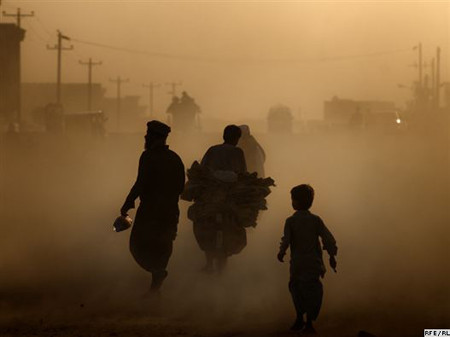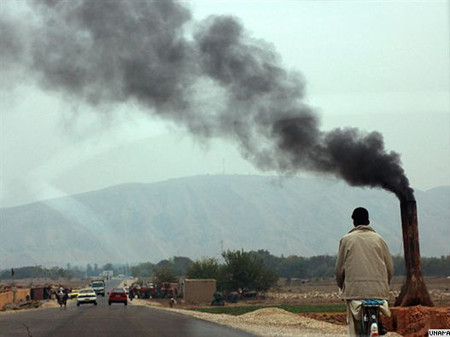By Helena Malikyar, Tanya Goudsouzian
Seventeenth-century Persian poet Saeb Tabrizi famously sang the praises of Kabul's lush gardens and sparkling water, extolling "the beauty of her trees" and "colorful tulips" and beseeching Allah to "protect such beauty from the evil eye of man."

RFE/RL, Mar. 15, 2011: Afghanistan’s National Environmental Protection Agency issued an advisory recommending the use of masks or other protective devices during the morning and evening rush hours in Kabul.By all accounts, air pollution is a potentially calamitous threat to public safety in Afghanistan. In its 2005-06 assessment, the UNEP reported that 60 percent of the population in Kabul is exposed to elevated concentrations of particulate matter, nitrous oxides, and sulphur dioxide. In the past nine years, there have been around 480,000 reported cases of respiratory illness and asthma, according to the Health Ministry. (Photo: RFE/RL)
Some 400 years later, the so-called king of poets must be rolling over in his tomb, as the last three decades seem to have brought much evil to this ancient city that connects Central and South Asia.
As Afghans prepare for Norouz, the ancient Zoroastrian New Year's festival heralding the beginning of spring, the stench of burning tires and leaded gasoline fills the air in lieu of the spirit of fertility and nature’s rebirth.
On the eve of the holiday, the international community offered yet another symbolic gesture toward addressing Afghanistan's critical environmental problems. U.S. Ambassador to Afghanistan Karl Eikenberry planted the first of the 240,000 trees that Washington has donated to Afghanistan, and the gift was graciously accepted by the mayor of Kabul as a significant contribution toward the reforestation of his city.
Unfortunately, Kabul's environmental problems cannot be solved by this horticultural donation alone. Nor can the alarming levels of air pollution be curbed by a recent government decision to make Thursdays nonworking days, thus expanding the weekend to two days. Afghan environmentalists called this act a clumsy bid to avoid effective measures while pretending to take steps.
Kabul streets are jammed with rattling jalopies, used privately or masquerading as taxis. Piles of rubbish and old tires are routinely burned for warmth by less fortunate residents and used as fuel in public bathhouses and brick kilns in the capital's suburbs.
Dramatic Deterioration
Experts agree that the government's lack of determination to implement environmental laws -- together with a lack of environmental awareness among the general populace, most of whom are grappling with urban survival -- has led to a dramatic deterioration of Kabul's once lush and fragrant urban landscape.
Emissions from old cars reportedly cause 70 to 75 percent of the air pollution in Kabul. And yet, tens of thousands of substandard, secondhand cars are imported every year. The resulting air pollution may lead directly to an estimated 3,000 annual fatalities, according to the Health Ministry. To put this in perspective, according to the United Nations, the number of reported civilian casualties in the war against the insurgency during 2010 was 2,777.
The United Nations Environment Program (UNEP) says that most of the fuels used in Afghanistan do not comply with international standards and contain high levels of lead. A study carried out by the Health Ministry in 2009 showed that the blood samples of 80 percent of some 200 Kabul residents contained lead.
The city of Kabul was built with an infrastructure to support 1 million residents. It was designed to allow a maximum circulation of 75,000 cars. In 1978, the city's population was estimated to be a little over half a million. Today, there are nearly 4 million people living in the capital and more than 400,000 cars are circulating -- not counting buses, freight trucks, and vehicles operated by the military, police, NATO, and the International Security Assistance Force (ISAF).
While an overabundance of older, substandard vehicles is among the chief causes of the deplorable quality of air in the Afghan capital, the problem is exacerbated by a lethal combination of gross negligence of solid and liquid waste; deforestation and the disappearance of wetlands; substandard generators built from old car engines; and the misguided use of coal, tires, and plastic for fuel.
What A Waste
Kabul's large population produces a large amount of garbage. And with no systematic garbage collection and disposal, the result is large piles of garbage on every street corner, scattered about by stray dogs during the night. In all urban centers, including Kabul, solid waste is dumped in valleys and open fields, some barely 10 kilometers from city centers. In addition to contributing to air pollution, these open landfills contaminate underground water. It costs $8 million to $10 million to construct a proper landfill, but no one has earmarked sufficient funds for this purpose.

RFE/RL, Mar. 15, 2011: Pollution from a brick factory in Baghlan Province. Emissions from old cars reportedly cause 70 to 75 percent of the air pollution in Kabul. And yet, tens of thousands of substandard, secondhand cars are imported every year. The resulting air pollution may lead directly to an estimated 3,000 annual fatalities, according to the Health Ministry. To put this in perspective, according to the United Nations, the number of reported civilian casualties in the war against the insurgency during 2010 was 2,777. (Photo: RFE/RL 2009)
Most of the city's hills and mountain tops are occupied by houses that lack sanitation and access to clean water. During rain and snow, runoff saturated with human waste is transported down the hills into the streets below. The mix eventually dries and is swept into the air by the wind and traffic.
By all accounts, air pollution is a potentially calamitous threat to public safety in Afghanistan. In its 2005-06 assessment, the UNEP reported that 60 percent of the population in Kabul is exposed to elevated concentrations of particulate matter, nitrous oxides, and sulphur dioxide. In the past nine years, there have been around 480,000 reported cases of respiratory illness and asthma, according to the Health Ministry.
The conditions are so dire that last year Afghanistan's National Environmental Protection Agency (NEPA) issued an advisory recommending the use of masks or other protective devices during the morning and evening rush hours. NEPA's alerts and recommendations have fallen on deaf ears.
Environmental experts argue that government negligence and corruption have impeded the implementation of environmental regulations. The government, they point out, has flouted NEPA recommendations on the prohibition on importing old cars and the rigorous implementation of emissions tests. Politicians routinely succumb to pressure or enticements from business.
Chain Reactions
Environmental issues work in chain reactions. Deforestation and the mismanagement of forests in the northwest, the east, and the southeast have not only contributed to damaging the ecobalance but have also taken the livelihood from tens of thousands of people whose traditional occupations were related to forestry. This phenomenon in turn has contributed to the population explosion in the urban centers.
By contrast, the Pakistani lumber business has boomed from illegally cut and exported lumber from eastern Afghanistan. Iranian pistachios now dominate the market due to a dramatic decrease in the quality of the harvest from the northwestern pistachio farms of Afghanistan.
The Afghan cabinet on January 30 ordered the immediate formation of a special commission to investigate Kabul's air pollution, identify its causes, and make recommendations for action. Thus far, nothing has been made public about the commission's status.
What better way to start a new year than to begin contributing, in earnest, to the process of nature's renewal and to restoring fresh air to the battered capital. President Hamid Karzai's government can dispel critics by actively showing it has the political will to give precedence to the environment rather than to individual interests for economic gain.
Regulations drawn up by NEPA and UNEP ought to be implemented, rather than cosmetic measures that only serve to protect those who are benefiting from unregulated emission production. The import of old cars simply must be stopped and regular technical checks imposed.
A rigorous environmental awareness campaign must be launched through the media, the pulpit, and workshops. Afghan civil society must be mobilized to become a partner in this awareness campaign. The dangers of toxic gases emitted from old cars; leaded fuel; and burning tires, plastic, and coal must be clearly, forcefully, and sustainably pounded into the public mind. Kabul residents must have access to efficient public transportation and must be encouraged to use bicycles for short journeys.
Finally, although environmental consciousness is a novel concept for Afghans, who have been busy fighting invaders and each other for the past three decades, the international community is well aware that today’s air pollution casualties will only increase exponentially -- if energy, resources, and imagination are not dedicated to cleaning up Afghanistan’s environment.
Helena Malikyar specializes in Afghan state-building. Tanya Goudsouzian is a journalist who has covered Afghanistan since 2001. The views expressed in this commentary are the authors' own and do not necessarily reflect those of RFE/RL



